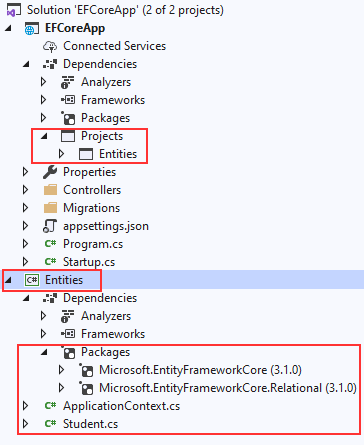
The edited file with the correct path is shown below: Now the key part in linking the *.tt file to your DB Model class is in the first couple of lines.ĭouble click to open the *.tt file, and you should see the following lines of code.Įdit the line that begins with “const string inputFile =”, and replace the value with the relative path to your edmx file.
#VISUAL STUDIO ENTITY FRAMEWORK PROJECT GENERATOR#
Select the EF DBContext Generator file type, call it “BudgetingModel.tt” (as below): The idea is that the Entity project will be referenced in our other projects (whether it be our UI or Business layer).Īdd a new Item to your Entity proejct. This project will house all your shared entities. lets do the split:Ĭreate another project called “Entity”. Expand this file, and there you have it! All the generated classes, tightly packed under the data model structure. Amongst this list is the BudgetingModel.tt file (highlight below). If you expand the edmx file, you will notice a handful of files that Visual Studio generated for us. Opening this file in Visual Studio and you will see your model diagram: Let us create a Data Model (I called mine BudgetingModel.edmx) inside the DataModel Project – This is the project that will provide data access via our repositories and db contexts.Īs you see below, we have our edmx file inside the DataModel project. In order to separate your EF DB Model from your Entitiy classes, it’s the simple operation of creating the new *.tt file in your Entity Project, and pointing this file to your Data Model.īelow I will show you the before and after pics of this splitting process:

The Text Template (TT) file is the parent file whereby all your EF classes stem from. The EF DBContext Generator generates files with the extension *.tt In comes the Entity Framework DBContext Generator. Yet, you want to re-use the Data Model classes, but don’t want to duplicate the classes in your Entity project (the project that contains your POCO, Presentation models and other classes you want to refernce in your UI layer).

You only want your Repository project to have this reference to your Entity Data Model project. You want to easily map your database tables and sql/linq queries to your data model classes, however you don’t want to expose your Entity Data Model project (especially the DB Context etc) to your UI Layer, or other layers that shouldn’t have this access.

So you want a clean application architecture for your projects and classes. In this article, I will show how you can achieve this in a few basic steps. You want to separate your Data Model classes into another project, so that you can add references to the Data Model classes without exposing your Data Model Contexts and connections. But Visual Studio automatically creates all the Data Model classes under your Entity Data Model file structure. SO you have decided to use an ADO.Net Entity Data model in your solution.


 0 kommentar(er)
0 kommentar(er)
